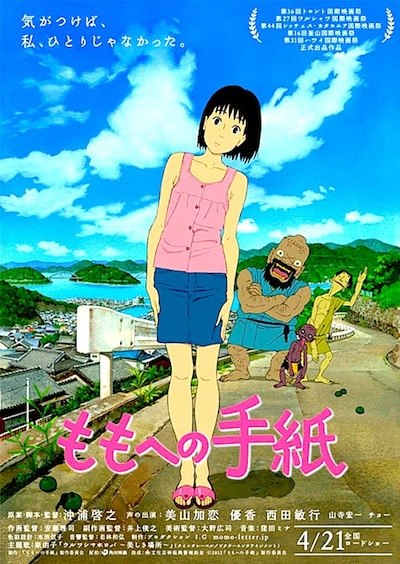By Joe Bendel. They are the supernaturally incompetent: former gods demoted to mere goblins. It is not hard to see why. They certainly do not impress a young Japanese girl mourning her father after an initial round of scares. Still, they seem to have a specific reason for hanging around in Hiroyuki Okiura’s A Letter to Momo, which screens during the 2012 New York International Children’s Film Festival.
Momo Miyaura bitterly regrets her last words to her late marine biologist father. They had a fight. To be more accurate, she really let him have it. Shortly thereafter, his ship went down. Going through his things, she finds a letter he started writing to her, but never got beyond the “Dear Momo.” For obvious reasons, this letter preoccupies her thoughts as she and her mother relocate to the remote island of Shio.
 Her stiff-upper-lip mother is not around much, leaving Miyuara with time on her hands. This becomes a real problem when she discovers three bizarre entities living in the attic and mooching their food. Apparently, nobody else around her can see them, with one exception having little bearing on the overall plot. At first she is understandably alarmed, but quickly gains the upper hand over the intruders. However, they continue to loiter about, making nuisances of themselves.
Her stiff-upper-lip mother is not around much, leaving Miyuara with time on her hands. This becomes a real problem when she discovers three bizarre entities living in the attic and mooching their food. Apparently, nobody else around her can see them, with one exception having little bearing on the overall plot. At first she is understandably alarmed, but quickly gains the upper hand over the intruders. However, they continue to loiter about, making nuisances of themselves.
Of the three, only the rather addled Mame looks anything like a traditional goblin. However, his slimy tongue and Zenned-out mannerisms make him the most original of the trio. Iwa the gentle giant is also appealing in an archetypal way, but the amphibious-looking Kawa has an unfortunate Jar Jar thing going on.
Only Okiura’s second film, following-up his breakout 1999 debut Jin-Roh: the Wolf Brigade, Letter has been compared to Studio Ghibli both in terms of style and subject matter. Indeed, it bears strong thematic similarities to The Secret World of Arrietty and Makoto Shinkai’s Miyazaki-influenced Children who Chase Lost Voices from Down Below (which also screened at this year’s NYICFF). Yet, Okiura consistently elevates the realistic family drama well above the many otherworldly creatures. That unwritten letter is not merely a metaphor. It serves a genuinely important role in the story, which is quite earnest and touching.
Almost entirely generated by hand, Okiura’s animation is quite striking. Evidently that is one reason his sophomore feature was so long in coming. Reportedly he resolved only to work with Japan’s top animators (including animation director Masashi Andô) and was willing to wait until their schedules cleared. The lush nature backdrops are definitely Ghibli-esque and their figures are unusually expressive, by any animation standard.
There is definitely something very universal to Momo’s story. Okiura tells it with grace and emotional conviction. Indeed, this is the rare animated film that might hit too close to home for youngsters and parents dealing with similar losses. For the rest of us, its unabashedly open heart is rather refreshing. Recommended particularly strongly, but not exclusively, for young girls, A Letter to Momo screens again Saturday (3/24) at the Asia Society as NYICFF continues at venues throughout New York.
Posted on March 19th, 2012 at 2:20pm.